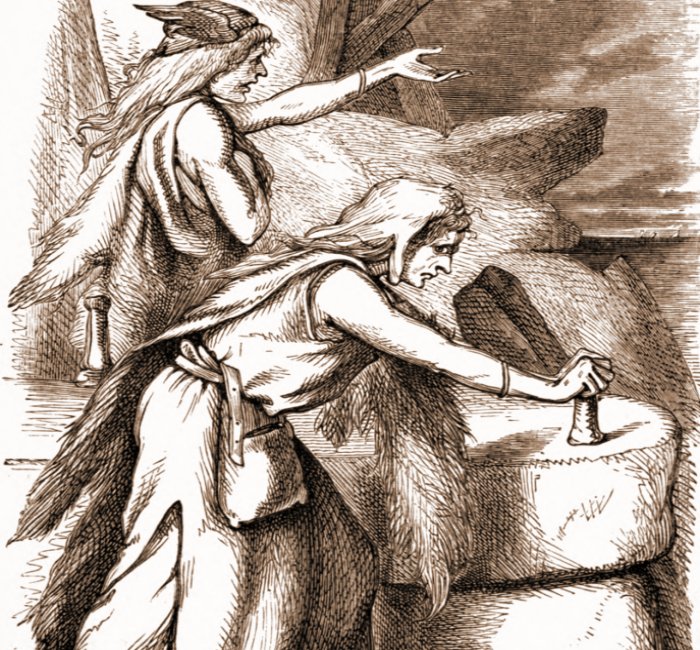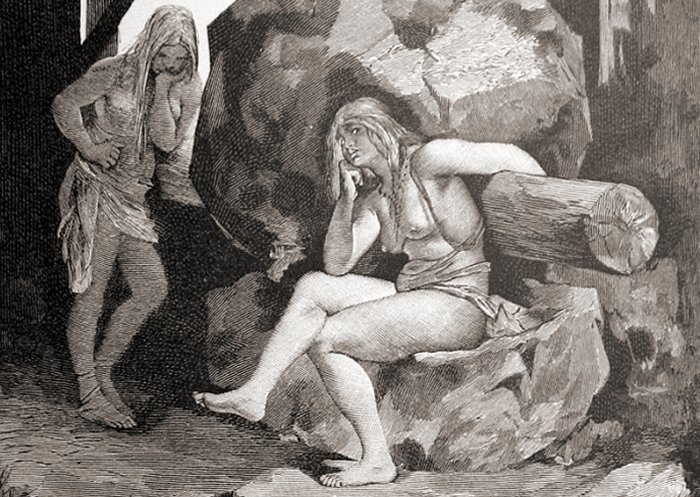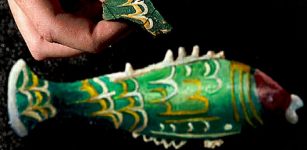Fenja And Menja: Two Giant Sisters, Magical Grotte Mill And Why The Sea Is Salt
A. Sutherland - AncientPages.com - In Norse legends, Fenja and her sister Menja were two giant maidens who mined gold in the Grotte (or the 'World Mill'). It was a legendary, magical mill with two massive millstones that no man had enough strength to grind.
 Menia (Menja) and Fenia (Fenja) by W. J. Wiegand, (fl. 1869–1882). source
Menia (Menja) and Fenia (Fenja) by W. J. Wiegand, (fl. 1869–1882). source
The magical mill could grind everything, both good things, including gold, peace, happiness, and terrible things like war, tragedy, and ruin.
Moreover, the mill's magic was that it could grind out what the mill drivers were singing about, but as legend has it, no one had been strong enough to operate the mill.
Initially, Fenja and Menja served for King Fjolner, who lived from the 1st century BC to the early 1st century AD and was the son of Frey (Freyr) and the giantess Gerdr (Gertha), the Ynglinga saga tells. Their story is also mentioned in 'Song of Grótti' (Grottasöngr), an Old Norse poem found in the Poetic Edda and preserved in one of the manuscripts Prose Edda by Snorri Sturluson.
Ruthless King Frode Bought Fenja And Menja
One day, Fjolner (Fjölner) was visited by a Danish King Frode (Frodi) from Zealand, the island, which - as told in the Gylfaginning - was created by Gefjon (Gefion). We remember that Gefjon was the Aesir goddess of fertility, plow, and agriculture.
She cleverly tricked Gylfi, the king of Sweden, by removing a piece of land and transporting it to Denmark, which became Zealand.
King Frode bought the slave giantesses, Fenja and Menja, to care for his powerful Grotti mill with magical properties. It is said that he got it from the mighty god Odin himself.
He was eager to put the women to work when he got home. Perhaps, King Frode's rule was prosperous and delivered a peaceful time for his people, but it was not the same for the giants. Frode was a cruel, heartless, and greedy man.
He had Fenja and Menja tied to the mill and ordered them to grind gold, peace, happiness, and prosperity for him. He did not allow the girls to sleep for more than a moment in his ruthless greed. The sisters could not rest more than the time it took to perform a song.
Was it their fate to be enslaved forever?
Even though mortals had enslaved Fenja and Menja, the girls, fortunately, knew that sooner or later, they would be able to take revenge.
Fenja's And Menja's Revenge
As the sisters worked with the mill, they soon discovered its supernatural powers and learned to control them. Thus, they created a power song we know today as the "Song of Grotte." Before the music ended, they ground an enemy army into existence via the magic mill. This army was led by a king, Mysing, "from over the sea," who was powerful enough to oust Frode, so he did.
 The engraving shows the giantesses Fenja and Menja beside the mill Grótti. One giantess is sitting near the center of the frame while the other is standing by the side. Carl Larsson (1853-1919) and Gunnar Forssell (1859-1903). Published in 1893. Original drawing created in 1886.
The engraving shows the giantesses Fenja and Menja beside the mill Grótti. One giantess is sitting near the center of the frame while the other is standing by the side. Carl Larsson (1853-1919) and Gunnar Forssell (1859-1903). Published in 1893. Original drawing created in 1886.
King Mysing quickly killed Frode and took the slave women and the Grotte mill on his ship with him.
Unfortunately, also this time, the girls had not much luck because Mysing was not better than Frode. Frode wanted unlimited quantities of gold, reminding us of King Midas, who – as told in an ancient Greek myth – was wealthy and greedy and loved gold more than anything else.
King Mysing, on the other hand, wanted to possess unlimited quantities of salt; he forced the sisters to grind it even harder without getting any rest.
Around midnight, they asked if there was not enough salt, but it was not. Mysing wanted more and ordered the women to continue grinding. In revenge for their endless suffering, the two giant women started to sing the "Song of Grotti," which brought misfortune to Frode. This time, however, the sisters did not intend to give up their fate but fought to the end.
They worked only a short time longer before the disaster happened.
In the sea, a gigantic vortex, known as the Maelstrom (Mill-Stream), formed by the sea spiraling through the hole in the millstone of Grotte. Mysing's ship broke down, was pulled down through this powerful opening, and sank. All Mysing's ships went down; the Grotte Mill also fell with them.
The sea began turning salt. Since then, the sea has been salty, says the myth.
Where Are Fenja And Menja Now?
According to some old stories, the two unhappy girls still work at the mill. One version of the myth says that the two sisters, no longer oppressed and humiliated by any man, happily returned to Jotunheim with Grotte, which they used to grind out gold dust and export to many places around the world. Their house - covered in gold dust - was often visited by people who wanted to steal the magical mill or the sisters' wealth. None of those visitors have yet survived to tell the story.
Another legend says that Stroma, an island off the northern coast of the mainland of Scotland, is known to have a dangerous whirlpool with a Norse name: Swelki ("sea mill"). Legend has it that two giant women, Grotti-Fenni and Grotti-Meni, live under the seafloor and cause dangerous whirlpools - an unavoidable threat to passing sailors.
Written by – A. Sutherland - AncientPages.com Senior Staff Writer
Updated on April 12, 2023
Copyright © AncientPages.com All rights reserved. This material may not be published, broadcast, rewritten or redistributed in whole or part without the express written permission of AncientPages.com
Expand for referencesReferences:
Stephen Liley, Olaf's Saga
Sturluson S. The Younger Edda
Sora S. The Triumph of the Sea Gods
More From Ancient Pages
-
 Stunning Facial Reconstruction Of Saint Ludmila’s Sons Of The Czech Royal Premyslid Dynasty
Archaeology | Mar 8, 2021
Stunning Facial Reconstruction Of Saint Ludmila’s Sons Of The Czech Royal Premyslid Dynasty
Archaeology | Mar 8, 2021 -
 Biblical Vineyard Of Naboth Existed And Has Been Found
Archaeology | Aug 3, 2017
Biblical Vineyard Of Naboth Existed And Has Been Found
Archaeology | Aug 3, 2017 -
 Lost Villa Of First Roman Emperor Augustus Found At Somma Vesuviana In Southern Italy
Archaeology | Apr 19, 2024
Lost Villa Of First Roman Emperor Augustus Found At Somma Vesuviana In Southern Italy
Archaeology | Apr 19, 2024 -
 Giant Turtle-Shaped Rock Wangsan, Korea – One Of The Strongest Sources Of “ki”
Featured Stories | Jun 24, 2015
Giant Turtle-Shaped Rock Wangsan, Korea – One Of The Strongest Sources Of “ki”
Featured Stories | Jun 24, 2015 -
 Europe’s Oldest Time Capsule Discovered Inside A Statue Of Jesus In Spain?
Archaeology | Dec 1, 2017
Europe’s Oldest Time Capsule Discovered Inside A Statue Of Jesus In Spain?
Archaeology | Dec 1, 2017 -
 Ostrich Eggshell Beads Reveal 50,000-Year-Old Social Network Across Africa
Archaeology | Dec 21, 2021
Ostrich Eggshell Beads Reveal 50,000-Year-Old Social Network Across Africa
Archaeology | Dec 21, 2021 -
 Remains of Santorini Volcanic Eruption Discovered West Of Suez Canal
Archaeology | Jan 3, 2016
Remains of Santorini Volcanic Eruption Discovered West Of Suez Canal
Archaeology | Jan 3, 2016 -
 Lincolnshire’s Prehistoric Henge And A Sacred Site Dating Back Hundreds Of Years
Archaeology | Apr 6, 2024
Lincolnshire’s Prehistoric Henge And A Sacred Site Dating Back Hundreds Of Years
Archaeology | Apr 6, 2024 -
 New Fossil Ape Challenges The Story Of Human Evolution
Evolution | Aug 24, 2023
New Fossil Ape Challenges The Story Of Human Evolution
Evolution | Aug 24, 2023 -
 Impressive Gaulcross Hoard Reveals Secrets Of Mysterious Picts
News | Jun 20, 2016
Impressive Gaulcross Hoard Reveals Secrets Of Mysterious Picts
News | Jun 20, 2016 -
 Why Did God Zeus Give King Sisyphus An Eternal Punishment?
Featured Stories | Sep 2, 2019
Why Did God Zeus Give King Sisyphus An Eternal Punishment?
Featured Stories | Sep 2, 2019 -
 Mysterious Megalithic Stones Of Carnac, France – An Unsolved Neolithic Enigma
Civilizations | Oct 12, 2018
Mysterious Megalithic Stones Of Carnac, France – An Unsolved Neolithic Enigma
Civilizations | Oct 12, 2018 -
 Rare 1,800-Year-Old Fragment From Fish-Shaped Roman Bottle Unearthed In Gloucestershire
Archaeology | Jul 23, 2019
Rare 1,800-Year-Old Fragment From Fish-Shaped Roman Bottle Unearthed In Gloucestershire
Archaeology | Jul 23, 2019 -
 Something Surprising Happened With Temperature Since The Start Of The Holocene – New Study
Archaeology | Oct 10, 2022
Something Surprising Happened With Temperature Since The Start Of The Holocene – New Study
Archaeology | Oct 10, 2022 -
 3,000-Year-Old Geoglyphs May Depict The Heavens
Archaeology | Jun 25, 2018
3,000-Year-Old Geoglyphs May Depict The Heavens
Archaeology | Jun 25, 2018 -
 Madagascar Cave Art Hints At Ancient Connections Between Africa And Asia
Featured Stories | Dec 18, 2023
Madagascar Cave Art Hints At Ancient Connections Between Africa And Asia
Featured Stories | Dec 18, 2023 -
 400-Year-Old Shipwreck Found Off The Coast Of Portugal Labeled ‘Discovery Of A Decade’
Archaeology | Sep 26, 2018
400-Year-Old Shipwreck Found Off The Coast Of Portugal Labeled ‘Discovery Of A Decade’
Archaeology | Sep 26, 2018 -
 Was The Mysterious Powerful Viking Warrior Buried In A Ship In Scottish Highlands A Woman?
Archaeology | Feb 12, 2017
Was The Mysterious Powerful Viking Warrior Buried In A Ship In Scottish Highlands A Woman?
Archaeology | Feb 12, 2017 -
 Ancient DNA Reveals Surprises About Life Of Early Africans
Archaeology | Feb 24, 2022
Ancient DNA Reveals Surprises About Life Of Early Africans
Archaeology | Feb 24, 2022 -
 Secret Ancient Knowledge Of Venus – Controversial Theory And Surprising Discovery – Part 1
Civilizations | Jun 30, 2018
Secret Ancient Knowledge Of Venus – Controversial Theory And Surprising Discovery – Part 1
Civilizations | Jun 30, 2018
